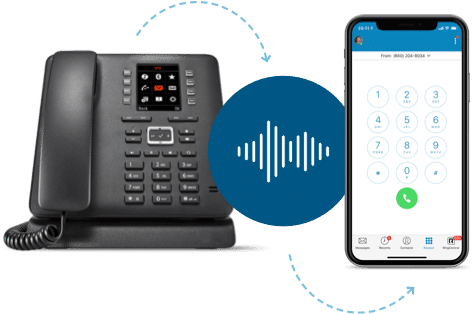What is SIP Trunking?
In simple terms, SIP trunking is the method used by many organisations to allow a business phone system to work over an internet connection as opposed to legacy systems and traditional telephone landlines.
As businesses seek to reduce costs in a challenging economic environment, SIP trunking is becoming increasingly popular. While many are familiar with terms and concepts such as VoIP (voice over IP), it’s important to know a little about the smaller details that work within, the broader VoIP system.
SIP trunking is a service that uses the same protocol that provisions VoIP, connecting on-premises systems to the PSTN (public switched telephone network).
SIP is used to establish calls and manage high volumes of calls. It is often appointed to replace digital PRIs (Primary Rate Interfaces) or as an updated alternative to traditional ISDN lines with a targeted switch-off date of 2025.
We see widespread uptake of SIP trunking as a service as businesses strive to modernise and update their legacy phone systems.
How SIP trunks work
Before we delve deeper into the benefits of SIP, let’s first break down the key components:
SIP is short for Session Initiation Protocol, an IP standard established by the Internet Engineering Task Force. SIP essentially dictates how a communications session is established and how it is terminated, initiating the connection between IP addresses. SIP technology can also send audio, images, video, and documents to support everyday voice calls. That also means, SIP users no longer have to maintain two separate networks for data and phone calls. While numerous protocols may be used in a VoIP system, SIP is the most common.

A SIP trunk is, in essence, a digital alternative to the analogue phone line that many businesses historically used to make phone calls. SIP allows users to connect one, two, or twenty SIP channels directly to a business PBX, meaning you can make long-distance phone calls via the internet. Using a SIP provider also means that those with an on-premises PBX can continue to make unrestricted outbound calls regardless of the number of calls taking place simultaneously.
Benefits of SIP trunking
Aside from the inevitable perks the peace of mind around generally modernising your business and ticking boxes on the path to digital transformation, there are several benefits of SIP trunking you may not be aware of. We’ve highlighted just a few of the advantages of SIP trunking below:
1. Cost savings
Making the switch to SIP might be a lot less overwhelming than expected and, in the long run, might save your business a significant amount. Local calls, international calls and long-distance calls were formally subject to varying charges, and SIP trunking afford more clarity from the off. Billed on a per-user basis, SIP charges are bundled together often leading to better, more manageable cost-efficiency for you and your teams.
2. Network consolidation
Many businesses maintain and pay for data and voice across separate networks, even if a single supplier provides these services. Using SIP allows businesses to merge voice and data into one single network, meaning voice calls essentially become a form of data transmission. Naturally, while it means there’s a little more strain on your capacity and connectivity capabilities, this can lead to significant cost savings in the long term.
3. Manageable infrastructure requirements
Unlike businesses using traditional phone systems and services, organisations that switch to SIP will benefit from opportunities for expanding the business infrastructure.
SIP technology makes your business more agile in terms of changes that may need to be made to enable a remote workforce. Historically, this would have incurred long periods of waiting time to allow the local telecommunications company to implement changes. New lines can be added easily, and the entire phone system is much more efficiently managed than with legacy phone systems.

4. Scalability and scope
SIP supports your organisation’s environment for significant growth. Combining voice and data into one network makes it far easier to allow remote working, helping businesses scale-up, and attracting a talent pool independent of your office’s physical location.
5. Unified Communications
In the same vein, switching to SIP opens the playing field to modernise your communications systems further. SIP can provide the first step towards a more unified communications system. Unlocking the benefits of a fully IP-based suite, modern businesses investing in UCaaS (unified communications as a service) can scale further, enhance productivity and efficiency and achieve more global appeal in talent acquisition.
6. Mobility
Investing in SIP technology allows your organisation to improve the mobility of your teams. Making use of the flexibility afforded by VoIP apps and more mobile-friendly solutions means that your employees can connect to your on-premises phone system from wherever they may be. This also has a positive long-term impact on your business continuity as the mobility benefits of SIP and VoIP solutions mean communications can be maintained even in the cases where your internet connection fails.
7. Business Continuity
SIP allows businesses to be more resilient, with a business phone system that is more reliable than legacy systems. In unpredictable disruptions or outages, SIP users can divert calls to another site, or another system so that business can continue as normal. When it’s increasingly important not to miss a call, SIP technology can play a significant role in any business’s disaster recovery plans.
Related reading: Best VoIP Phones For Your Home Or Your Business
How Can SIP Trunks Help Your Business?
Aside from the above, choosing to implement SIP can greatly impact your businesses’ bottom line. With only a small upfront investment and the low-risk SIP element as a well-established, trusted option, many organisations who invest in SIP reap the rewards almost instantly in terms of their ROI. Without the initial outlay of capital investment, and limited need for physical hardware, organisations that choose to switch to SIP can observe significant cost savings from the outset.
What’s more, with SIP, your business can add business phone lines by connecting employees’ handsets to your data connection. This means you can significantly improve your reliability; ensuring your customer calls are always answered, while also enriching the employee experience by allowing much more flexibility and the agility to work reactively and in-line with their own work-life balance.

How to Choose SIP Provider
Choosing a SIP provider that offers mobile-failover can be particularly beneficial as it means you can route calls to employees mobile devices or another office in the case of an outage or other disruptions.
SIP also boasts some major advantages in terms of ownership and management. Most SIP providers with SIP trunking and VoIP phones come with user-friendly management portals. These online administrative dashboards mean your business administrators or IT personnel can avoid lengthy calls with customer service, implementing simple management processes such as call routing and editing, or adding extensions and phone lines in-house.

How to Deploy SIP Trunks?
The deployment of your SIP trunking might vary depending on your business goal and, ultimately, how you use your business phone system, but for the most part, SIP deployment should follow the following steps:
1. Planning
Creating a thoughtful, detailed plan for your SIP migration is key to ensuring the implementation runs as you predicted, without too many teething problems. It’s a good idea to initially run a detailed audit and an inventory of your current equipment (taking into account multiple business sites), and plan your future predicted costs after making the switch. Be sure to think about any impact the deployment will have on your network and whether you need to make additional arrangements. Be sure to consider call volumes, peak times and bear in mind any security implications too.
Consider whether your business has more than one site, and bear in mind that there are two core models for SIP deployment: centralised or decentralised. A centralised configuration will mean direct inbound calls to a single site (usually the head office).

While this model is easy to implement and manage, it’s worth considering that centralised deployment might mean you have a single point of failure, meaning, if there is an issue with the SIP trunk, you lose service across all sites. Decentralised configuration can be a little more costly as it means more maintenance, software and equipment across all offices. However, it does mean you minimise the risk of losing service across your entire organisation if there is an issue in one location.
2. Research
Evaluating the market’s potential offerings is key; thinking carefully about the providers that sit well with your business. Consider researching a shortlist of potential SIP providers; then you’ll need to thoroughly examine the capabilities and terms of service of those potential suppliers. Take the reputation of your potential supplier into account and examine their experience in VoIP deployment.
3. Run a trial
Conducting a pilot trial gives you a chance to test out your SIP installation, testing it following your day-to-day processes. Outline the trial criteria beforehand so that you can effectively measure the success of your SIP pilot trial. Your trial should include aspects such as training and employee adoption so that you can make the most of the technologies capabilities whilst you test it.
4. Company-wide roll-out
Once you’ve completed a successful pilot trial for your new SIP technology, it’s time to roll-out the technology for the rest of the business. Ensure users receive comprehensive training on any new platforms and feel confident using any new processes and systems. Be sure to inform users of the wider benefits of SIP, so that they feel involved in the ‘bigger picture’ and your new project receives the buy-in it deserves from your stakeholders and your internal teams.
SIP Trunks vs SIP Channels
The term ‘trunking’ is used to describe the concept of multiple calls sharing the same phone line instead of one call per line. In essence, SIP trunks are the enabler for the transfer of multiple calls and data via a single network connection. A SIP trunk is the ‘container’ of these multiple call lines, while the SIP channel is simply the line or the channel which provides a path for these simultaneous calls to take place.
How to select the right SIP Trunk provider
Choosing to switch to SIP is an easy decision. Once you’ve decided to update your phone system and invest in SIP technology, it’s important to take the time to research your potential SIP partners.
Start by making sure you ask the right questions, taking the following aspects into careful consideration:
-
Security
With cybercrime on the rise, the topic of security should be high on your agenda, and therefore you should be sure to choose a supplier that takes security seriously. Look out for terms like Transport-Layer Security (also known as SSL) cryptographic protocol, ensuring your connections are safeguarded and private. STRP (Secure Real-Time Transport Protocol) enables an added security layer by allowing live encryption of audio streams.
-
Connectivity
Raise any connectivity concerns early when choosing your supplier, simply asking your provider what they recommend, should give you a little insight. If they take the time to understand your business’s needs, it should help you feel confident in the partnership. Consider assured broadband or leased line to make sure you can maximise opportunities to scale up and manage high call volumes.
-
Support
Be sure to choose a SIP provider who works alongside you from the planning stage right the way through to implementation and offers ongoing support for any queries or challenges that may arise. Your SIP partner needs to understand the specific deadlines of your business.
A trustworthy SIP provider should offer estimated time scales for your deployment project that allow you to minimise costly downtimes. Ideally, you’ll want to select a provider with experience, one that can guide you through the process smoothly, while anticipating and mitigating any arising challenges.

Originally published Jan 18, 2021, updated Jul 13, 2021


